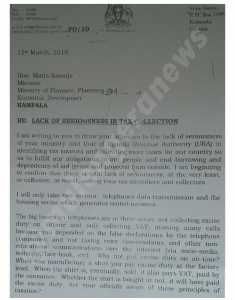In a leaked letter dated March 12th, 2018 addressed to the Minister of Finance, Planning and Economic development, Hon. Matia Kasaija where the tax collecting body Uganda Revenue Authority (URA) falls, the President apparently expressed the lack of unseriousness by the ministry and tax body to identify viable sources that could generate tax to the government and offset borrowing and dependency on aid.
Cited among these tax sources is telephone data transmission and housing but let us stick to telephone data transmission and its effects to the general telephony consumers.
Apparently the president goes on to name the three areas that the ministry and tax agency have missed including not collecting excise duty on Airtime, missing revenue due to unscrupulous call declarations from telecom companies and not taxing voice conversations and non-educational communications on over the top (OTT) channels that were further revealed as Facebook, Whatsapp among others.
Still on the issue OTT services, the letter goes on to read that if government were to introduce a small fee of UGX 100 per day on every sim card that access these services,the government coffers could register an excess of UGX 400 Billion per year. The estimate was an approximate of minutes calculated as being used by Ugandans.
The estimate also leaves out undeclared calls and data by the telephone companies. These on their own could generate a magnitude of $400 million per year.
The letter recommends that all this has to do with excise duty on Airtime and OTT services. However the president’s recommendations except educational and research services.
What does this mean to the general consumer?
If this proposal is effected, it will either mean an increase in airtime prices which is unlikely or a reduction in minutes or data volumes allocated to end users of both talktime/airtime and data respectively.
Still on the UGX 100 charge on OTT users, that even becomes a puzzle as the possible way of implementing this is on the network side, still through airtime or data volumes awarded to subscribers unless a new mechanism comes into play lest it calls for going against net neutrality.
The issue of taxing OTT services directly is contentious as these maintain no physical operations in the country thus the name over the top. These however use data pipes (networks) provided by telecom companies on ground which the government can easily tax.
The other possible way of taxing them actually is taxing a selected section of end users that normally transact on them or buy ads on these services. It should also be noted that majority of the OTT services are free to use yet they generate revenue from countries where they operate.
Telecoms on one hand have long stressed to charge OTT service for traffic through their pipes, an issue that was contested on the other end as these have led to a reduction in revenue generated by traditional circuit switched calls and old time SMS, that are major revenue streams for telecoms.



